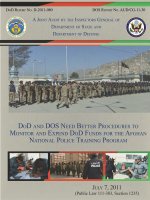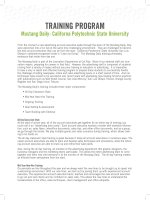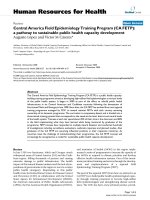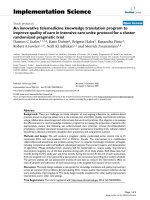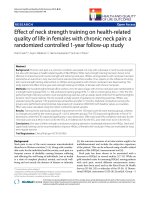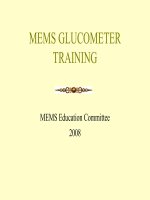Ethiopian field epidemiology training program (EFETP) compiled body of works in field epidemiology
Bạn đang xem bản rút gọn của tài liệu. Xem và tải ngay bản đầy đủ của tài liệu tại đây (3.21 MB, 186 trang )
ADDIS ABABA UNIVERSITY, SCHOOL OF PUBLIC
HEALTH
Ethiopian Field Epidemiology Training
Program
(EFETP)
Compiled Body of Works in field
Epidemiology
By
ALIY ENDRISS
AHMED
Submitted to the School of Graduate Studies of Addis Ababa University
in Partial Fulfillment for the Degree of Master of Public Health in Field
Epidemiology
June 7-2017
Addis Ababa
ALIY ENDRISS AHMED EFETP,2017
1
Addis Ababa University
College of Health Sciences
School of Public Health
Ethiopian Field Epidemiology Training Program (EFETP)
Compiled Body of Works in Field Epidemiology
By
ALIY ENDRISS
Submitted to the School of Graduate Studies of Addis Ababa
University in partial fulfillment for the degree of Master of Public
Health in Field Epidemiology
Advisors
Mr. Teklehaymanot G/Hiwot
Dr. Niguse deyessa
June 2017
Addis Ababa
ALIY ENDRISS AHMED EFETP,2017
2
ADDIS ABABA UNIVERSITY
School of Graduate Studies
Compiled Body of Works in Field Epidemiology
By
ALIY ENDRISS
Ethiopian Field Epidemiology Training Program (EFETP)
School of Public Health, College of Health Sciences
Addis Ababa University
Approval by Examining Board
_______________________________
__________________
Chairman, School Graduate Committee
_________________________
Advisor
_________________________
___________
Examiner
_________________________
_____________
Examiner
ALIY ENDRISS AHMED EFETP,2017
3
ACKNOWLEDGMENT
First and for most my deepest thank goes to almighty Allah for his priceless and unlimited
support and gift throughout my life. I want to express my deepest appreciation to Mr.
Teklehaymanot Gebrehiwot and DR. NIGUSE, EFETP mentors for their kind and
constructive review of my works.
I would like to express my grateful appreciation to the Ethiopian Field Epidemiology
Training program director Dr. Zegeye Hailemariam, Academic coordinator of the program
Dr. Adamu Addisse and Ms. abigiya abtow and Dr. Alemayehu Bekele program coordinator
from the Ethiopian public health association for their unreserved technical and
administrative support.
I would like to put across my grateful appreciation to the organizations: Addis Ababa
University, Federal Ministry of Health, Amhara national regional state Health Bureau,
CDC/Ethiopia, Ethiopian Public Health Association,
District
Health
Offices,
Health
facilities and all other sectors who supported me in any aspect of my work during my all
residency time.
Finally, I would like to thank healthcare providers, health extension workers and the
community who supported me during data collection time.
ALIY ENDRISS AHMED EFETP,2017
4
Table of Contents
ACKNOWLEDGMENT ..................................................................................................................................... 4
LIST OF TABLE................................................................................................................................................ 6
LIST OF FIGURES ............................................................................................................................................ 7
LIST OF ANNEX .............................................................................................................................................. 8
LIST OF ABRIVAITION .................................................................................................................................... 9
EXCUTIVE SUMMARY .................................................................................................................................. 11
CHAPTER I: OUT BREAK INVESTIGATION.................................................................................................... 12
Chapter II—surveillance data analysis ........................................................................................................ 52
Chapter III—surveillance system evaluation .............................................................................................. 69
Chapter IV – Health Profile Description Report .......................................................................................... 86
Chapter V—Scientific Manuscript for peer reviewed journals ................................................................. 106
Chapter VII – Narrative Summary of Disaster situation visited ................................................................ 122
CHAPTER VIII –Protocol/Proposal for Epidemiologic Research Project .................................................... 135
ALIY ENDRISS AHMED EFETP,2017
5
LIST OF TABLE
Table 1: Distribution of scabies cases and attack rate by age group in bati woreda, oromia zone, Amhara
Region, Ethiopia, 2016 ................................................................................................................................ 26
Table 2: Distribution of scabies cases and attack rate by sex in bati woreda, oromia zone, Amhara
Region, Ethiopia, 2016: ............................................................................................................................... 26
Table 3: Summary of bivariate analysis of risk factor for scabies outbreak, bati district oromia zone
Amhara, Ethiopia, 2016 .............................................................................................................................. 27
Table 4: Distribution of AWD cases by age group attack rate in jile tumuga district, oromia zone, Amhara
Region, Ethiopia, 2016. ............................................................................................................................... 45
Table 5:Multi-variate analysis of factors associated with AWD in cases and controls in Jile tumuga
district, oromia zone, Amhara region, Ethiopia, 2016. ............................................................................... 47
Table 6: The comparison of the study results zonal summary with international Standards, July 2011June2016, oromia zone Amhara region, North West Ethiopia. .................................................................. 65
Table 7: Budget allocation of kemissie town, Amhara region, 2014/2015 ................................................ 95
Table 8: number of health facilities and the ratio to the population in kemissie town, 2014/2015 . ........ 96
Table 9: The health professional to population ratio in kemissie town, 2014/2015 . ................................ 96
Table 10: The comparison of the study results zonal summary with international Standards, June/2011June/2016, oromia zone Amhara region, North West Ethiopia ............................................................... 116
Table 11: Population distribution of rapid meher needs assessed districts, oromia zone, Amhara Region,
June, 2016. ................................................................................................................................................ 126
Table 12: Top five cause of morbidity by district, oromia zone Amhara, 2016. ....................................... 128
Table 13: Case/death trend of outbreak prone diseases by month, meher season assessed districts,
oromia zone, Amhara Region, sep/2016 .................................................................................................. 130
Table 14: Anticipated epidemics in oromia zones Amhara Region, 2016 G.C . ........................................ 131
Table 15: Budget break down for EPI project ........................................................................................... 143
Table 16: project implementation for EPI project ................................................................................... 144
ALIY ENDRISS AHMED EFETP,2017
6
LIST OF FIGURES
Figure 1: map of bati district, Amhara region, 2016 ................................................................................... 17
Figure 2: frequency of parts of body affected by scabies lesion among the scabies cases of bat district,
Amhara, 2016.............................................................................................................................................. 22
Figure 3: frequency of parts of body affected by skin sores among the scabies cases of bat district,
Amhara, 2016.............................................................................................................................................. 23
Figure 4: Number of scabies cases by date of onset of disease, bati district, Amhara, 2016 .................... 24
Figure 5: numbers cholera cases by kebeles of Bati district, Amhara, Ethiopia, 2016 ............................... 25
Figure 6: Map of jile tumuga districts, Amhara region, 2016 ..................................................................... 36
Figure 7: Frequency of sign and symptom among the AWD cases of jile tumuga districts, Amhara, 201642
Figure 8: AWD cases by kebele, Jile tumuga district, Amhara region, 2016 ............................................... 43
Figure 9: Number of AWD cases by date of onset of disease, Jile Tumuga, 2016 ...................................... 44
Figure 10: number of AWD case by age and sex of Jile tumuga, Amhara, 2016 ........................................ 46
Figure 11: Map of oromia zone, Amhara region, 2016 ............................................................................... 56
Figure 12: Number SAM cases by district and year in under–five children in Oromia zone Amhara region,
July/2011-june/2016. .................................................................................................................................. 58
Figure 13: Trend of zonal malnutrion cases by year in Oromia zone, July2011 – June2012 ...................... 59
Figure 14: Relative frequency of severe acute malnutrition by districts in oromia zone, Amhara region
from July/2011-June/2016.......................................................................................................................... 60
Figure 15: Percent of OTP admition of from the target of under-five children, oromia zone Amhara
region, North West Ethiopia from July 2011-June 2016 ............................................................................. 61
Figure 16: Recovery rates SAM under 5 children in Oromia zone by district July/2011-June/2016 .......... 62
Figure 17: Death rates of SAM under 5 children in oromia zone by districts and zonal summery
July/2011-June2016 .................................................................................................................................... 63
Figure 18: Defaulter rate of SAM in under-five children by district in oromia zone, July/2011-june/2016
.................................................................................................................................................................... 64
Figure 19: Maps of oromia zone, Amhara region, 2016 ............................................................................. 74
Figure 20: completeness of health facility of oromia zone, Amhara region 2016 ..................................... 82
Figure 21: timeliness of health facility of oromia zone, Amhara region, 2016 ........................................... 82
Figure 22: Map of kemissie Administrative Town, Amhara, 2016 .............................................................. 90
Figure 23: Distribution of population by kebele of kemissie town, Amhara 2014/2015 ........................... 92
ALIY ENDRISS AHMED EFETP,2017
7
Figure 24: The demographic indicator of kemissie town Amhara region, 2014/2015. ............................. 93
Figure 25: Distribution of number of student by sex at different level of education in kemissie town,
Amhara, 2014/2015. ................................................................................................................................... 94
Figure 26: Top 10 cause of morbidity for above 5 years category for kemissie town district health office,
2014/2015 ................................................................................................................................................... 97
Figure 27: Top 10 of morbidity for under-five years’ category for kemissie town district health office,
2014/2015. .................................................................................................................................................. 98
Figure 28: The coverage of ANC, PNC and PMTCT coverage kemissie town, Amhara, 2014/2015 ............ 99
Figure 29: coverage of BCG, MEASELS, PENTA 3, OPV and PCV of kemissie town, Amhara, 2014/2015... 99
Figure 30: TB detection, cure rate, success rate and defaulter rate of kemissie town, Amhara,
2014/2015. ................................................................................................................................................ 100
Figure 31: coverage of VCT, PICT, PMTCT and the prevalence of HIV of Kemissie town, Amhara
2014/2015. ................................................................................................................................................ 102
Figure 32: Number SAM cases by woreda and year in under-five children in Oromia zone Amhara region,
July/2011-June/2016 G.C. ......................................................................................................................... 110
Figure 33: Trend of Zonal Malnutrion cases by year in Oromia zone, July/2011 – June/2016 ................ 111
Figure 34: Percent of OTP admition from the target of under-five children, oromia zone Amhara region,
North West Ethiopia July/2011-June/2016G.C. ........................................................................................ 112
Figure 35: Recovery rates SAM under 5 children in Oromia zone by district July/2011-June/2016 G.C . 113
Figure 36: Death rates of SAM under 5 children in oromia zone by district July/2011-June/2016 G.C. .. 114
Figure 37: Defaulter rate of SAM in under-five children by woreda in oromia zone, July/2011-June/2016
G.C. ............................................................................................................................................................ 115
Figure 38: Map of Oromia zone, Amhara region, 2016 ............................................................................ 125
Figure 39: Admission of the therapeutic feeding programme for SAM management, oromia zone,
Amhara region, Jan 2016-sep2016. .......................................................................................................... 133
Figure 40: map of Artuma fursi district, Amhara region, 2016 ................................................................. 139
LIST OF ANNEX
Annex 1: Data collection tools for case control study on scabies............................................................. 145
Annex 2: Data collection tools for case control of AWD investigation ..................................................... 148
Annex 3: Data collection tools for surveillance system evaluation .......................................................... 156
Annex 4: Data collection tools for Rapid meher assessment- Health Sector. .......................................... 179
ALIY ENDRISS AHMED EFETP,2017
8
LIST OF ABREVIATIONS
Based on WHO mortality stratum
AFR-D
African Region, stratum D
AFR-E
African Region, stratum E
EMR-B
Eastern Mediterranean Region, stratum B
EMR-D
Eastern Mediterranean Region, stratum D
SEAR-B
South-East Asia Region, stratum B
SEAR-D
South-East-Asia Region, stratum D
WER
Weekly Epidemiological Record
WPR-B
Western Pacific Region, stratum B.
AWD
Acute watery diarrhea
CFR
Case fatality rate
PHEM
Public health emergency management
HW
Health worker
HEW
Health Extension worker
RDT
Rapid diagnostic test
CTC
Cholera treatment center
EFETP
The Ethiopian field epidemiology training
program
CDC
Center for disease control prevention
EIS
Epidemic intelligence service
EPHI
Ethiopian public health institute
EPHA
Ethiopian public health association
WHO
World health organization
AR
Attack rate
ALIY ENDRISS AHMED EFETP,2017
9
AOR
Adjusted odd ratio
COR
Crude odd ratio
CI
Confidence interval
MDA
Mass drug administration
NGO
Non-governmental organization
SAM
Sever acute malnutrition
GAM
Global acute malnutrition
OTP
Outpatient treatment program
SUN
Scale up nutrition
RUTF
Ready to use food
CBN
Community based nutrition
MUAC
Middle upper arm circumstance
MDG
Millennium development goal
IHR
International health regulation
SARS
Severe acute respiratory syndrome
CSF
Cerebral spinal fluid
AURTI
Acute upper respiratory tract infection
AFI
Acute febrile illness
VCT
Voluntary counseling and testing
PICT
Patient initiation counseling and testing
UTI
Urinary tract infection
PMTCT
Prevention of Mather to child transmission
ANC
Antenatal care
PNC
Postnatal care
TFP
Therapeutic feeding program
EPRP
Emergency preparedness and response plan
ALIY ENDRISS AHMED EFETP,2017
10
EXCUTIVE SUMMARY
The Ethiopia Field Epidemiology Training Program (EFETP) is a two years competency based
Master’s program adapted from the United States Centers for Disease Control and Prevention
(CDC) Epidemic Intelligence Service (EIS) Program. Addis Ababa University, the Federal
Ministry of Health of Ethiopia/Ethiopian Public Health Institute (EPHI), the Ethiopian Public
Health Association (EPHA), and Centers for Disease Control and Prevention Ethiopia and
Regional Health Bureaus run the program jointly. It comprises of 25% class learning and 75%
field activities, working in public health emergency and other health related priority issues. It
is designed to assist the Ministry of Health in building or strengthening health systems
by selecting promising health workers and building their competencies through on the job
mentorship and training. Ethiopia adopted the field epidemiology training program to help
improve leadership in the public health emergency management system.
This compiled body of works composed of eight chapters accomplished during the two years
residency period. It comprises outbreak investigations, surveillance data analysis report,
surveillance system evaluation, health profile description report, scientific manuscript for peer
reviewed journals, abstracts for scientific presentation, narrative summary of disaster
situation visited, protocol or proposal for epidemiologic research project.
All the outputs during the residency period were compiled as single document. The first
chapter consists of outbreak investigations. Two outbreaks were investigated, cholera outbreak
in Jile tumuga district in Sep, 2016 and Scabies outbreak in bati district in June, 2016. The
second chapter is surveillance data analysis on sever acute malnutrition in oromia zone Amhara
region North West Ethiopia, February 2016. Surveillance system Evaluation was conducted in
oromia Zone, Amhara region, July 2016, Health profile description report was conducted in
Kemissie town district, January 2016. One manuscript was prepared for peer reviewed journals
and one abstract was prepared. Summary narrative report of rapid meher assessment done in
oromia zone, in October, 2016 conducted together with other relevant sectors and partners, is
included in the seventh chapter. Proposal for epidemiologic research project is also prepared
Prevalence of intestinal shistosomiasis and the risk factors associated with shistomiasis among
elementary school children in Artuma fursi district of oromia zone, Amhara region, North West Ethiopia.
ALIY ENDRISS AHMED EFETP,2017
11
CHAPTER I: OUT BREAK INVESTIGATION
1.1
SCABIES OUT BREAK INVESTIGATION IN BATI WOREDA ,OROMIA ZONE AMHARA
REGION NORTH WEST ETHIOPIA , 2016
ABSTRACT
INTRODUCTION Scabies is a highly contagious skin disease caused by a parasite is a mite that
burrows under the skin. The causative agent of human scabies is the mite, Scarcoptes scabiei. A
WHO review collated data from 18 prevalence studies between 1971 and 2001, and reported a
scabies prevalence ranging between 0.2% and 24%. In some underdeveloped countries,
prevalence has been reported to be between 4 and 27% among the general population. We
aimed to identify the magnitude of scabies outbreak and risk factors.
Methods: We conducted scabies out break investigation in bati district from March 12- 13,
2016 and Case-control study design was used. We used simple random sampling methods to
select randomly from the line list and two controls for one case were selected by using
systematic random sampling method from the neighbors of cases and structured questionnaire
was used to collect data.
RESULTS In bati districts out of the total scabies cases (142 cases) reported in bati districts
46(32%) were under 15years and 73(51%) were female. More than half 89(63.3%) of the case
had history of slept with contracted scabies and 92(64.5%) had seen scabies lesion and
118(83.3%) had skin sores. The attack rate was highest in age <5 years (335per 100,000
population) followed by age 5-9 years with (232/100,000 population).
CONCLUSION Children less than 9 years of age were more affected group during the outbreak
.Basing scabies cases and putting clothes with scabies case were risk factor for scabies occur, on
the other hand detergent used to take shower and frequency of washing clothes were protective
for scabies therefore avoiding contact with scabies cases and promoting hygiene and sanitation
were best solution to prevent scabies.
ALIY ENDRISS AHMED EFETP,2017
12
Key words: scabies outbreak, bati district, case control study.
Word count: 273
INTRODUCTION
Scabies is a highly contagious skin disease caused by a parasite is a mite that burrows under the
skin. The causative agent of human scabies is the mite, Scarcoptes scabiei. Mites are tiny
arthropods related to spiders and ticks. Although mites in general are very diverse in terms of
what they feed upon and where they live, the scabies mite is an obligate ectoparasite which
must live on the outside of a mammal host to survive. The scabies mites are thought to be a
single species, but with several physiological varieties or subspecies. The many variants of this
species are generally considered to be very host-specific. Therefore, S. scabiei var. hominis,
found on humans, can only develop and reproduce on a human host. The human scabies mite
tends to prefer areas of folded skin (e.g., web between fingers, under buttocks, elbow and wrist
area, around genitals, etc.) for burrowing(1).
The primary mode of transmission of the human scabies mite is direct skin contact between
two individuals. Mites are good crawlers and can crawl up to 2.5 cm ~ 1 inch per minute on the
surface of the skin. Although mites cannot jump, they can readily move to a new individual
when skin-to-skin contact is made. Once on a new host individual, the mites can start to burrow
within minutes. Currently, there are no published studies that have determined the minimum
contact time necessary for the mites to transfer from person to person. Therefore, any person
who has direct contact with someone who has scabies may be at risk for infestation(1).
The most common symptom is a rash that is very itchy, especially at night .The rash can be
anywhere on your body but is most common on the hands, breasts, elbows, knees, wrists,
armpits, genital area, and waistline. Often the rash looks like red bumps or tiny blisters, which
form a line. Symptoms begin 2 to 6 weeks after the first exposure to scabies, or 1 to 4 days after
re-exposure. Scratching may cause skin to become infected with bacteria (germs)(1).
ALIY ENDRISS AHMED EFETP,2017
13
Treatment of scabies on individuals and reduction of skin-to-skin contact with infected
individuals is recommended as the primary means of eliminating the infestation. Although
transmission via fomites is possible, regular housekeeping and hygienic measures such as
changing and washing of bedding in hot water followed by drying materials in a mechanical
dryer at the highest temperature setting (preferably 120º F or hotter) should be adequate to
prevent further spread. Currently, 5% permethrin cream is the recommended treatment for
scabies infestation and Permethrin is a synthetic pyrethroid that paralyzes the scabies mite
eventually causing death. Ivermectin is 90% - 95% effective with one dose (200 ug/kg)(1).
The prevalence and complications of scabies make it a significant public health problem in the
developing world, with a disproportionate burden in children living in poor, overcrowded
tropical areas (2). Exhaustive and complete data are not available from many countries, but
such data as can be utilized suggest that scabies is endemic in tropical regions, with an average
prevalence of 5–10% in children. A WHO review collated data from 18 prevalence studies
between 1971 and 2001, and reported a scabies prevalence ranging between 0.2% and 24%(3) .
A number of epidemiological factors have been proposed as influencing the distribution of
scabies infestation in populations, including: age, gender, ethnicity, overcrowding, hygiene,
and season being related to social and environmental changes such as wartime, overcrowding,
and climatic changes(4).
The prevalence of scabies varies. In some underdeveloped countries, prevalence has been
reported to be between 4 and 27% among the general population. In underdeveloped
countries, scabies tends to have a higher prevalence in preschool children and adolescents,
whereas in developed nations, prevalence is similar in all ages. It is no longer accepted that
epidemics of scabies occur in 30-year cycles due to changes in the immune status of the host
population. The two pandemics coincided with the two World Wars. Besides these two
pandemics, localized and unrelated epidemics do occasionally occur as noted in New Zealand
and in Germany in the 1930s. No regular cycling in incidence is apparent(4).
In Malaysia during 2010 the prevalence of scabies among children in welfare home in Pulau
Pinang. Children aged 10-12 years showed the highest prevalence followed by 7-9 years age
ALIY ENDRISS AHMED EFETP,2017
14
group and lastly the 4-6 years age group. More males were affected by scabies. The overall
prevalence rate for scabies was 31%(5).
In Palestine the average annual incidence rate of scabies in the West Bank during the period
2005–2010 based on 1734 patients was 17/ 100 000 populations. The average annual incidence
rate for the individual governorates ranged from 1.3/100 000 population in Tubas governorate
to 41.4/100 000 population in Jericho governorate(6).
IN Egypt during 1998, Scabies was diagnosed in 239 patients during the whole study period (14
months). The initial prevalence rate of scabies among the village residents was 5.4%. Scabies
affects persons of all ages; however, the risk of developing scabies was highest among children
under 10 years (7).
The study in Cameroonian boarding schools during 2015, indicate that the prevalence of human
scabies 17.7% among whom 223 boys (66.0 %). There were significantly more infected boys
than girls. Ages of these infected students ranged between 9 and 20 years(8).
The study of infectious skin diseases among Egyptian school children in urban and rural areas
during 2008-2010 indicate that, the prevalence of scabies (1.3%)(9).
Scabies was common among different part of Ethiopia, the study done in Amhara region tach
gaynt indicate that a total of 2969 scabies case were reported from the tach gaynt. Of those
cases 1436 (48.3%) were female. The overall attack rate for all categories of age was 9.4 %. The
age specific attack rate was higher for people older than 60 years and relatively lower for
children under five years of age(10)
RATIONAL OF THE STUDY: The aim of the study is to identify the magnitude of scabies outbreak
and risk factors.
Objectives
ALIY ENDRISS AHMED EFETP,2017
15
General objectives
To identify the risk factors for the occurrence of scabies outbreak and select appropriate
control measures.
Specific objectives
To describe the magnitude of the disease in the district
To analyze risk factors for the occurrence of the outbreak
To select appropriate prevention and control measures.
Methods and Materials
Study area
Bati district is one of the rural districts found in oromia Zone, Amhara Region. The district is
located at a distance of 405 kms from Addis Ababa and 540 kms from regional town Bahir Dar,
and the district was bordered by south wello in west and by afar in south, east and north. The
district has total population of 96418 and with male 45966 female 50452. The district has 26
rural kebele, and six health centers and 26 health posts with physical health service coverage is
100%.
ALIY ENDRISS AHMED EFETP,2017
16
Figure 1: map of bati district, Amhara region, 2016
Study period: The study was conducted from March 10-25, 2016 .
Study design: Case-control study design was used and matched by sex, age and residential area
ALIY ENDRISS AHMED EFETP,2017
17
Target population: All populations in bati district where cases and controls found.
Study population: All cases and populations from nine kebeles of bati district in which case and
controls were selected.
Sample size and sampling procedure: By using simple random sampling methods cases were
selected randomly from the line list. Controls were neighbors of cases who did not develop
scabies during the period of the study. Line list was reviewed and by using simple random
sampling suspected scabies case were identified in bati districts from March 10/2016 to march
12/2016 using standard case definition and 30 case who fulfill the case definition were selected
from the total 142 cases and two controls for one case per were selected by using systematic
random sampling method from the neighbors of cases and a total of 61 control were selected
and selected into the study.
Sample size was calculated using Epi-info 7 statcalc for matched case-control study by taking
Two sided confidence level (1-α) = 90%
Power (% chance of detecting) = 80%
Ratio of controls to cases = 2
Proportion of controls with exposure =15% (8)
Proportion of cases with exposure = 40% (8)
Odds Ratio to be detected = 3.77
When the sample size is calculated Using Epiinfo statcalc a total of 91 samples 30 cases, and
61 controls were selected using a control to case ratio of 1:2.
ALIY ENDRISS AHMED EFETP,2017
18
Inclusion &Exclusion criteria
Inclusion criteria
Cases Any resident of bati districts who had symptoms of scabies based on WHO case definition
and who agreed to participate in the study was included.
Controls A control was any resident of bati district during the study who was a neighbor to a
case and who did not develop signs and symptoms of scabies based on WHO case definition
and agreed to participate was included.
Exclusion criteria
Cases that did not fulfill the signs and symptoms of scabies based on WHO case definition and
who was not present during the study period were excluded.
Data collection: Structured questionnaire adopted from others study was used to collect data
for case-control study and using line list. Data was collected by principal investigator and coinvestigator including HW at district and health center levels by translating the questionnaire
into Afan Oromo and Amharic.
Data quality control
The data was primarily collected by principal investigator and co-investigator. Prior to entering
the data into the computer the missing variables and consistency of filling of questionnaires
and completeness of data was checked every day during data collection.
Data entry and Analysis
Data was entered and analyzed using Epi-info 7. After data cleaning and recoding advanced
statically analysis were under taken. Results were presented using graphs, tables, charts and
attack rate was calculated. Odds ratio, 95% CI, and p-value were constructed to measure
association and significance.
ALIY ENDRISS AHMED EFETP,2017
19
Variables
Dependent variable
Scabies
Independent variables
Age
Contact history
Occupation
Residence
Educational status of family
Marital status
Detergent to take shower
Knowledge
Frequency of taking shower
Ethical clearance
Letter of permission was written from Amhara field base to Bati district health office, where the
outbreak took place. The outbreak investigation was done after permission obtained from Bati
district health office.
WHO case definitions
1. Suspected case: A person with signs and symptoms consistent with scabies.
2. Confirmed case: Examining the skin scrapings microscopically in which mites, mite eggs or
mite feces have been identified by a trained health care professional.
ALIY ENDRISS AHMED EFETP,2017
20
3. Contact: A person without signs and symptoms consistent with scabies who has had direct
contact (particularly prolonged, direct, skin-to-skin contact) with a suspected or confirmed
case in the two months preceding the onset of scabies signs and symptoms in the case.
RESULT
Descriptive epidemiology
The outbreak lasts for four months beginning from 01/01/2016—01/04/2016 with 142 cases of
scabies and no death the attack rate was 147 per 100000population.
Out of the total cases reported in bati district 46(32%) were under 15years and the scabies
were not more common in older age with the median age (8 years).
Out of the total scabies cases (142 cases) reported from bati district 73(51%) were female and
89(63.3%) of the total case were not attend formal education. More than half 89(63.3%) of the
case had history of slept with someone infected by scabies.
All of the cases respond itching intense at night time .Majority of the cases 128(90%)
experienced itching first and only the remaining 14(10%) experience rash first.
More than half of the cases 92(65%) had scabies lesion and 118(83%) had skin sores.
ALIY ENDRISS AHMED EFETP,2017
21
40%
35%
34%
30%
25%
20%
17%
15%
10%
6%
6%
5%
3%
0%
finger web
face palm and sole ulner border of the
(children)
hand
inter glutal area
wrist
Figure 2: frequency of parts of body affected by scabies lesion among the scabies cases of bat
district, Amhara, 2016
Mostly affected Parts body of scabies cases by scabies lesion were 48(34%) had scabies lesion
on finger web, 24(17%) had skin lesion on face palm and sole and 8(6%)skin lesion on ulner
border of the hand and inter glutal area and 4(3%) had scabies lesion on wrist.
ALIY ENDRISS AHMED EFETP,2017
22
30%
27%
25%
20%
17%
15%
13%
10%
10%
10%
7%
5%
0%
finger web
face palm ulner border
and sole of the hand
elbow
anterior
axilaries line
umblicus
Figure 3: frequency of parts of body affected by skin sores among the scabies cases of bat
district, Amhara, 2016
Mostly affected body Parts of scabies case by skin sores were 38(27%) had skin sores on finger
web, 24(17%) had skin sores on face palm and sole and 19(13%) had skin sores on ulner border
of the hand and 14(9.9%) had skin sores on elbow and anterior axillaries line.
ALIY ENDRISS AHMED EFETP,2017
23
14
12
number of cases
10
8
6
Investigati
on stared
Date out
break
reporte
Index
case
4
2
0
date of onset
Figure 4: Number of scabies cases by date of onset of disease, bati district, Amhara, 2016
The outbreak lasts for four months beginning from 01/01/2016—01/04/2016 and the maximum
number of case were reported 12/12/2016-11/3/2016.
ALIY ENDRISS AHMED EFETP,2017
24
Legend: 1 dote represent one case
Figure 5: numbers cholera cases by kebeles of Bati district, Amhara, Ethiopia, 2016
Majority of the cases 107(75%)cases were from gure kebeles and followed by gerfa werene
kebele 11cases and hato kebele 10 cases but the remaining 6 kebeles cover from (1-4) cases.
ALIY ENDRISS AHMED EFETP,2017
25



